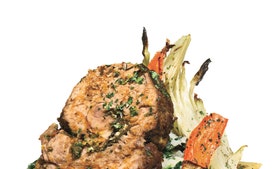
Introduction
Embark on a culinary journey with the classic Braised Veal Shoulder with Gremolata and Tomato-Olive Salad, a dish that promises to elevate your dinner experience. This hearty recipe marries robust flavors of veal with fresh zest from gremolata, creating an irresistible combination that will leave you craving more.
Tips for this Recipe
To ensure the perfect braise and a tender veal shoulder, consider patting the meat dry before browning. This step helps in achieving a better sear and crust on your veal. Additionally, allowing enough time to cook low and slow is key; it not only enhances flavor but also ensures that the veal falls off the bone.
Why you will love this recipe
This Braised Veal Shoulder with Gremolata and Tomato-Olive Salad offers a perfect balance of savory, sweet, and tangy flavors. The combination of slow cooking and robust ingredients guarantees that each bite is as satisfying as the last. It’s not just a meal; it’s an experience that will become your go-to for special occasions.
Ingredients
- 3/4 cup chopped fresh Italian parsley
- 6 large garlic cloves, finely chopped
- 3 large tablespoons finely grated lemon peel
- 4 teaspoons chopped fresh rosemary
- 1 5-pound boned trimmed veal shoulder clod roast
- Coarse kosher salt
- 3 tablespoons extra-virgin olive oil, divided
- 2 cups chopped onions
- 2 medium carrots, diced
- 1 cup chopped celery
- 1/2 cup dry red wine
- 2 cups low-salt chicken broth
- 1 1/2 cups drained diced canned tomatoes (from a 14.5-ounce can)
- 2 large garlic cloves, chopped
- 1 tablespoon chopped fresh rosemary
- 3/4 cup halved pitted kalamata olives
Adviced equipment
– Le Creuset Commercial Slow Cookers Collection – Dutch Oven Braiser (6 Quarts)
– Nordic Ware Cast Iron Skillet, 12″ Fry Pan
– All-Clad Stainless Steel 2.5 Quart Casserole with Lid, Oven Safe to 450°F
– Rubbermaid Multi Surface Food Safe Mixing Bowl Set, White, 12 Cup with Lids
– OXO Good Grips Restaurant Serve & Carry Set, Stainless Steel, 8″ x 9″ Dinner Plate with Pitcher, Lid Cover, and Coasters
– WÜSTHOF Bamboo Cutting Board Set – 6 Pieces, Heavy Duty Wood Block
– OXO Good Grips Stainless Steel Meat & Vegetable Grate with Lid, Set of 2 (Note: Suited for grating)
– OXO Good Grips Stainless Steel Soup Bowl with Lid
– Rubbermaid Food Storage Container Set – Quart Glass Lids with Silicone Liner, Clear, 3 Piece
– Rubbermaid Multi Surface Food Safe Mixing Bowl Set, White, 8 Cup with Lids and Straw Cover
– OXO Good Grips Nonstick Silicone Slotted Flexible Spatula with Handle and Lid, Set of 2
History of the Recipe
Braised veal shoulder with gremolata has its roots in Italian cuisine, often associated with meatballs or simmered meats. The term ‘gremolata’ comes from the word ‘gran mona’, meaning “great nun”, referring to the rich and luxurious nature of this dish historically served in opulent kitchens.
The evolution of gremolata, a mixture of lemon zest, garlic, and parsley, is linked to Italian culinary traditions. It was typically used as a garnish for meat dishes to brighten the flavors and add texture. The combination with veal shoulder represents an adaptation that has been cherished over generations.
Braising this particular cut of beef, which comes from the shoulder area, allows it to become fall-off-the-bone tender after prolonged cooking. This method is not only a nod to traditional slow-cooked meats but also aligns with modern preferences for rich, hearty dishes.
Fun Facts about this Recipe
Did you know that braising veal shoulder transforms it from being tough to tender enough to disintegrate in your mouth? This cooking technique has been passed down through the ages and is a testament to the timeless wisdom of using slow-cooking methods.
Gremolata, beyond its role as a garnish, acts as a culinary bridge between generations. It’s said that the lemon zest used in gremolata adds not only flavor but also health benefits like vitamin C and antiozymatic properties.
In today’s world of fast-paced life, recipes like this are a reminder to slow down and appreciate the art of cooking. As you savor each bite, consider it an act of cultural preservation, connecting you with centuries of culinary tradition.



